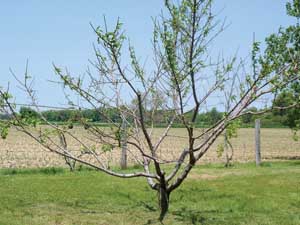
This 5-year-old Red Haven is on its last legs after two consecutive hard Michigan winters. It failed to bloom last year, and this year leafing is sparse, many twigs are dead, and there’s now little shoot growth. ( Richard Lehnert/Good Fruit Grower)
After two hard winters in a row, the freestone peach crop in Michigan is coming up short again this year, and may be short in the future.
Trees are dying in some orchards. Otherwise across the eastern United States, the peach crop looked good in early June.
Holly Mozal, the USDA’s peach market reporter in the state’s of Pennsylvania, Maryland, Virginia, and West Virginia, said the bloom in those areas was normal and there appeared to be little winter damage. The peach crop in Georgia was considered typical, even after a cold spell in March.
Dr. Bill Shane, peach breeder at Michigan State University’s Southwest Michigan Research and Extension Center, said he thought there’s 50 to 60 percent of a crop in his area, where many of Michigan’s fresh market peaches are grown. The USDA has not yet made any official estimate of the state’s crop size.
“Older trees took it hard the last two years,” Shane said. Temperatures on some sites fell to -20°F on a few days last winter, a repeat of what happened the previous year.
Adding to the stress, trees were still hardening off when cold temperatures came early last November, Shane said, so some of the wood injury occurred then.
On dormant trees in mid-winter, -15°F is cold enough to kill most peach flower buds, and at colder temperatures damage occurs to trunks, limbs, and shoots, according to MSU extension educator Mark Longstroth.
After winter injury, trees look like they’re aging prematurely. In addition to a lack of flowers, they show poor growth, with little tufts of leaves instead of vigorous foliage production. They shed leaves early.
“When the cambrium layer is damaged, the trees don’t grow new wood or new bark,” he said.
Injury was more likely in inland areas away from the protection of Lake Michigan. “Many trees there will have to be replaced,” Longstroth said.
Up until recently, the hardest winter on peaches and grapes was 1994. Encouraged by a long warming trend in the succeeding 19 years, both peach and wine grape growers were enticed to plant less cold-hardy varieties.
Jerry Frecon, who retired from Rutgers University as New Jersey’s peach expert two years ago, said that a common pattern was for winter cold tree injury to lead to cankers and then to tree death.
“We haven’t seen that in the last 10 to 15 years,” he said, as winters were milder. “There are a lot of varieties that don’t crop heavily after a cold winter, and growers planted some of those.” Growers in the mid-Atlantic states and further north are seeing varieties bred in California or the Southeast tested for their cold hardiness the last two winters, he said.
Growers needing to replant peach trees should be able to find them, Frecon said, although fewer nurseries grow peach trees nowadays after focusing their attention on providing apple and cherry trees, where demand is booming. •






Leave A Comment